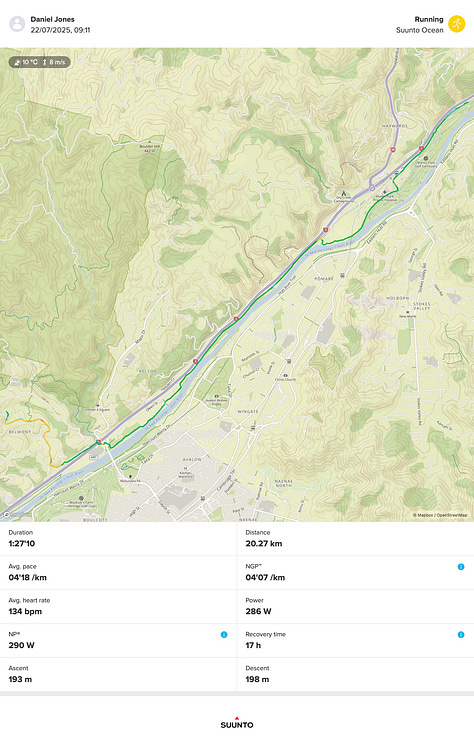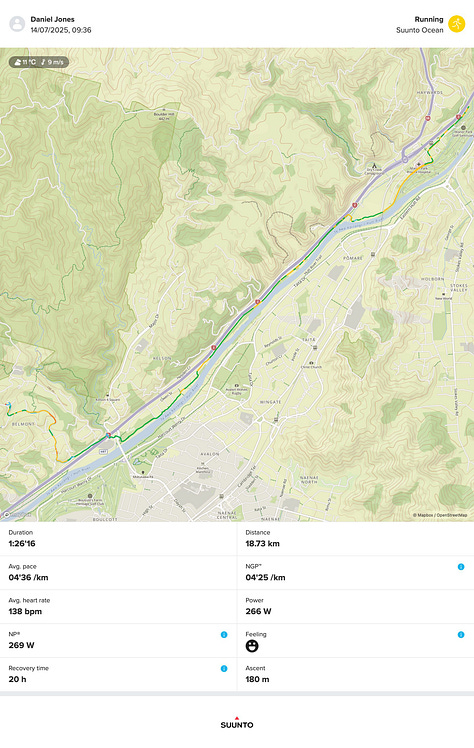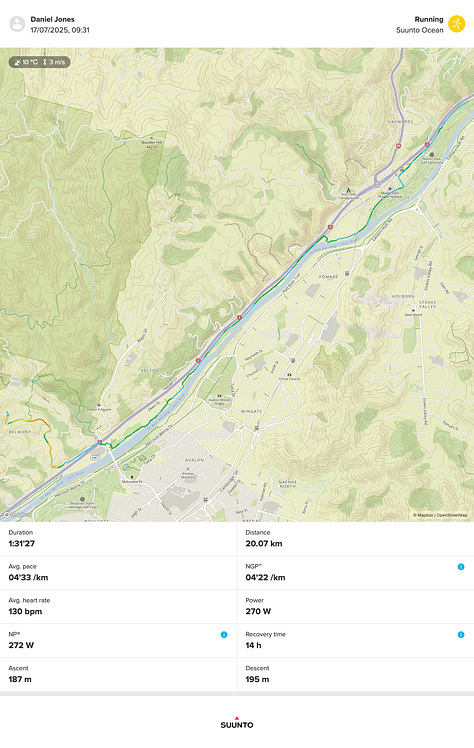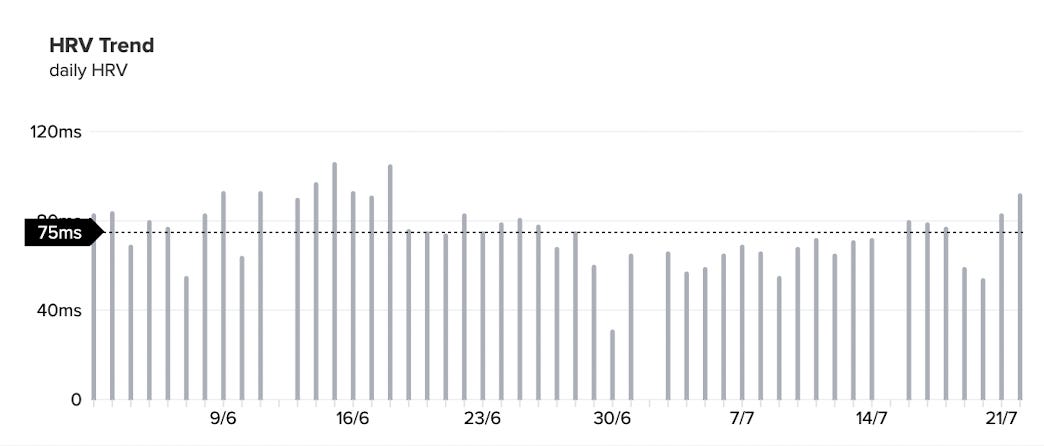The Art (and Data) of Recovery
Listening to the body, reading the numbers, and trusting the post-race process.
After a race like Western States, recovery is a lot about rest, but it’s all about tuning in, especially with another race around the corner… I’ve learned over the years that the body often whispers before it screams. That whisper might come as heaviness in the legs, restlessness, or even a surprising amount of energy. But how do you know when to push and when to pull back?
With experience I’m leaning into both intuition and information—paying close attention to how I feel, but also using technology (like my Suunto Race) to track the patterns I can’t always sense. It’s a blend of old-school listening and new-school feedback. And that balance is what will hopefully help me bounce back and be ready for Chamonix at the end of August.
Two Very Different Recoveries
Last year, after Western States, Michelle and I went straight into full holiday mode. We flew from the US to Costa Rica, posted up at a resort with all-inclusive cocktails and buffet spreads, and properly switched off. For a few days, the thought of running didn’t cross my mind (too much)—and that was the point.
We then spent about a week travelling and exploring the country. Trails were scarce, so if we found something runnable, we made the most of it. But overall, running was on the back burner. From there, we headed to London briefly where it was fun to explore and get out for a some nice flat runs, then on to adidas HQ for some testing in Germany, and then finally to Chamonix—where Michelle and I hiked/jogged the full Tour du Mont Blanc together over four days. That was an amazing shared experience and a beautiful way to transition back toward trail time before racing CCC.
This year has been very different.
Instead of continuing to travel, I flew straight home to Wellington. It’s meant more routine, more structure—but also more space to reflect. That can be a double-edged sword. You have time to think about everything that went right (or wrong), but the upside is I’ve also had time to be intentional about recovery.
Being home has allowed me to reconnect with my local trails and reintroduce some tools—like poles—that I’ll need heading into the next training block. I’ve been able to slowly work them back in on familiar terrain without pressure. It’s a more grounded approach this time around, and I’ve felt the benefit of that.
Listening First
In the first couple of weeks post-Western States, I gave myself space—not to train, but to move when it felt good. Some days that was a short shuffle. Others it was no running at all, just spinning on the wind training (watching Le Tour), or a hike. The goal wasn’t to get back quickly but to come back better.
Here’s what I waited for before layering anything structured back in:
Heavily reduced lingering muscle soreness or tightness in the mornings.
Natural desire to move, not obligation
Mental freshness—I wanted to train, not just go through the motions
I’ve learned that forced training in this window doesn’t build—it breaks and usually at a later stage when the race is right around the corner. So I gave the body what it needed: patience, food, movement, a lot of sleep, and time (although not much). Hopefully this mix of things will help me come back strong into UTMB.
Then, the Feedback Loop
I didn’t ignore the data. Quite the opposite. I used it as a second opinion.
Through heart rate variability (HRV), sleep tracking, and training load insights from my Suunto Race, I could see whether what I was feeling aligned with what my body was actually doing under the surface.
Some key trends:
Resting HR returned to baseline by day 10
HRV climbed steadily through the second week. Now in the 90’s after hovering between 50 and 60 for a while.
Recovery time predictions shrank after each effort, not grew.
Sleep got deeper and is still consistently over 9 hours.
That’s when I knew things were heading in the right direction. And then I tested it…
📊 Three-Run Recovery Comparison
To spot the trend, I compared three similar runs I’d done over the past couple weeks. All were on the same route, run at a steady aerobic effort — no real focus on pace, just effort and form.
Here’s how they stacked up:



📍14 July
Solid aerobic run post-WSER. Felt flat, with higher heart rate and longer recovery — body still absorbing fatigue.
Note: This run had the same elevation gain and decline (I just didn’t run out quite as far).
📍17 July
Smoother running with lower heart rate and quicker recovery, despite a slightly longer and faster run — efficiency returning.
📍22 July
Legs feeling snappy. Big lift in pace and power with stable heart rate — clear signs of regained fitness.
These aren’t breakthrough numbers. I’m not ripping out sub-3:30s or seeing super-low heart rates. But that’s not the point. What jumps out is the trajectory:
Same course.
Similar climate and time of running
Similar effort.
Gradual pace gains.
Rising power.
Declining (or stable) heart rate.
Shorter recovery time.
Better subjective feel.
In short: I’m moving faster and more efficiently, and I’m bouncing back quicker. That’s real progress — and more importantly, it feels like it.
My HRV
Heart Rate Variability (HRV) Trend
Over the past few weeks, my HRV has been gradually trending upward — a promising sign that my system is kicking back into gear. There were a couple of expected dips, especially around my bush mission and the night spent sleeping in a hut, but otherwise the trend looks solid. Notably, the HRV readings the night before each of my three runs climbed from 69 to 80 to 93 ms — a reflection of improving readiness that aligned closely with how each run felt and performed.
Bridging Feel and Feedback
What this post-race period reminded me is this: recovery isn’t passive. It’s not just about doing less—it’s about paying attention more.
Listen first. Then cross-check with tools. And if both are telling you the same thing? You can move forward with confidence.
Western States took a lot. But by listening closely and checking in along the way, I’ve started building back stronger… Hopefully!
A big shoutout to Suunto for the watches I’ve been using and such quality info I’m getting from the Suunto App.
And, a massive thanks to everyone for your support.
If you’ve enjoyed this read, hit the subscribe link below & you’ll receive each fortnightly write up direct to your email. Looking for further insights? Join our paid subs crew for access to AMA’s, additional training data and more.




